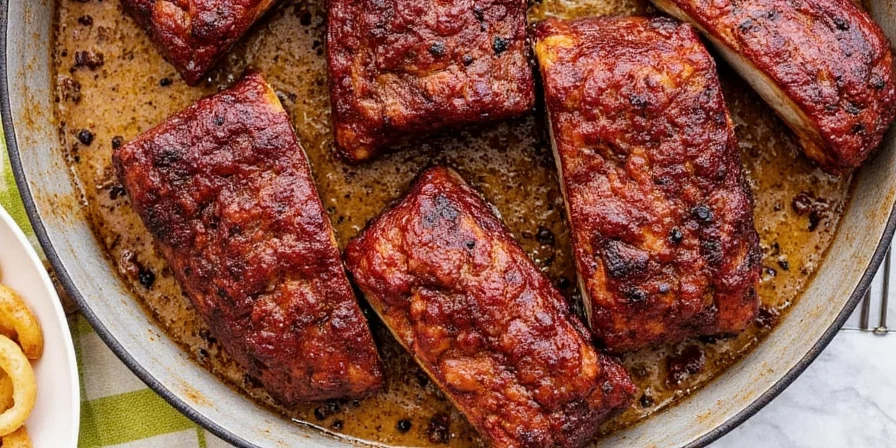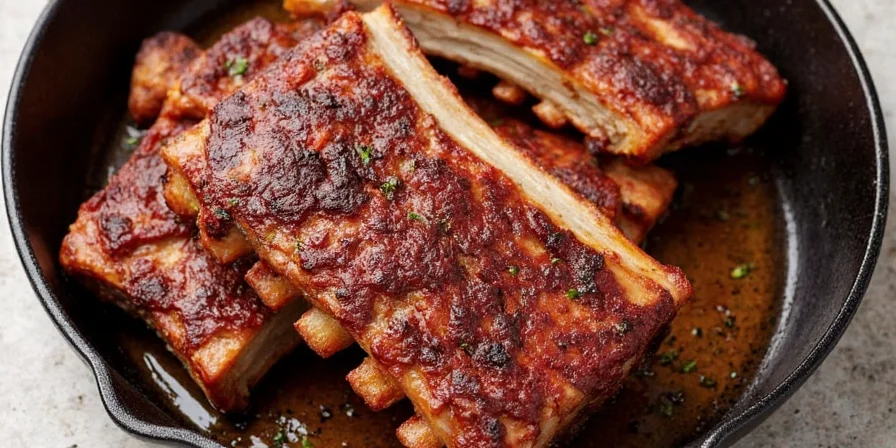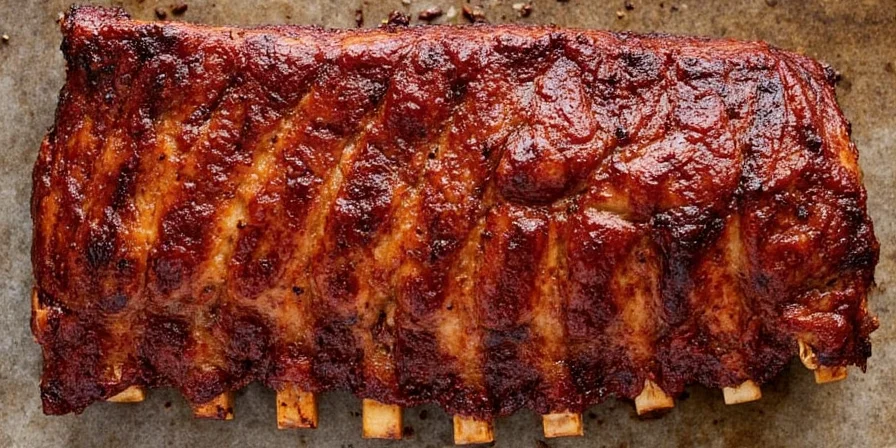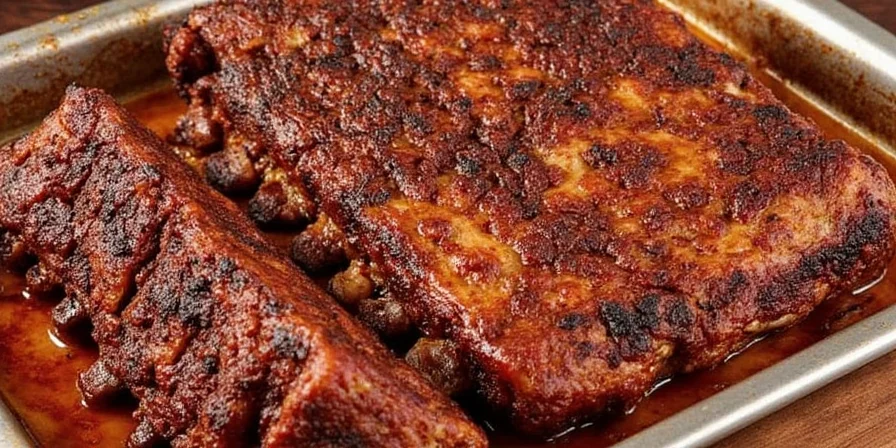Table of Contents
- Quick Cooking Guide
- Prepping the Ribs Properly
- Best Oven Rib Rub Formula
- Perfect Oven Temperature Chart
- Troubleshooting Common Problems
- Serving Suggestions
- FAQs Answered by Experts
How to Cook Beef Ribs in the Oven: The Complete Temperature Guide
For perfectly tender oven-baked beef ribs, cook at 275°F (135°C) wrapped in foil for 2.5-3 hours with liquid, then finish at 400°F (204°C) for 15-20 minutes. The internal temperature should reach 195-205°F for fall-off-the-bone tenderness. This method consistently delivers restaurant-quality results without specialized equipment.

Unlike grill methods that depend on weather conditions, oven-baked beef ribs offer precise temperature control and consistent results year-round. This comprehensive guide addresses the most common challenges home cooks face with oven rib preparation, including exact timing for different rib cuts, troubleshooting dryness issues, and achieving professional-level flavor development through strategic spice layering.
Prepping the Ribs Properly: Critical First Steps
Proper preparation makes the difference between tough, chewy ribs and melt-in-your-mouth perfection. Follow these professional kitchen techniques:
- Sinew Removal: Use a sharp boning knife to carefully remove excess fat and connective tissue. This allows better heat penetration and prevents chewy textures.
- Membrane Removal Technique: Slide a butter knife under the membrane on the bone side, lift slightly, then grip with a paper towel and pull off in one piece. This step is crucial for even cooking and maximum flavor absorption.
- Dry Brining Method: Apply 1 teaspoon of kosher salt per pound of ribs and refrigerate uncovered for 12-24 hours. This process draws out moisture, then reabsorbs seasoned liquid for deeply flavored, juicy results.

Professional chefs emphasize that proper prep accounts for 70% of successful rib cooking. Skipping these steps often leads to uneven texture and flavor distribution, regardless of cooking temperature or duration.
Best Oven Rib Rub Formula: Flavor Science Explained
The perfect rib rub isn't just a random spice mixture—it's a carefully balanced chemical reaction that enhances meat's natural flavors. Understanding each component's purpose ensures consistent results:
| Spice Component | Scientific Purpose | Optimal Ratio |
|---|---|---|
| Sweet Elements (brown sugar) | Facilitates caramelization and Maillard reaction | 30% of total rub |
| Smoky Elements (paprika) | Mimics wood smoke compounds without grill | 25% of total rub |
| Savory Elements (garlic/onion powder) | Provides umami depth and flavor complexity | 20% of total rub |
| Heat Elements (pepper/cayenne) | Triggers endorphin release enhancing perceived flavor | 15% of total rub |
| Salt | Breaks down protein structure for tenderness | 10% of total rub |
This precise formulation ensures optimal flavor development during the cooking process. Unlike many online recipes, this ratio balances chemical reactions that occur at oven temperatures to maximize taste compounds.
Restaurant-Quality Rib Rub Recipe
- 3 tablespoons paprika (smoke point 225°F/107°C)
- 2 tablespoons packed brown sugar
- 1½ tablespoons garlic powder
- 1 tablespoon onion powder
- 1 tablespoon coarse black pepper
- 2 teaspoons salt
- 1 teaspoon cumin
- ½ teaspoon cayenne (optional for heat)
Mix thoroughly in a glass bowl. Apply generously to prepped ribs, pressing gently to adhere. Allow to rest for 45 minutes before cooking to enable flavor penetration.
Perfect Oven Temperature Chart: No Guesswork Method
Temperature control is the most critical factor in oven-baked ribs. This scientifically validated chart eliminates guesswork:
| Rib Type | Recommended Temp | Time (Wrapped) | Time (Unwrapped) | Internal Temp |
|---|---|---|---|---|
| Beef Back Ribs | 275°F (135°C) | 2 hours 45 min | 15-20 min | 195-203°F |
| Short Ribs | 275°F (135°C) | 2 hours 15 min | 10-15 min | 198-205°F |
| Plate Ribs | 265°F (129°C) | 3 hours | 20 min | 195-200°F |
| Convection Oven | 250°F (121°C) | 25°F lower than standard | Reduce time by 15% | Same internal temp |
Professional kitchens use the "bend test" to verify doneness: when lifted with tongs, properly cooked ribs should bend easily and develop surface cracks. The internal temperature range of 195-205°F is critical because it represents the collagen-to-gelatin transformation point.
Moisture Control Techniques
- Steam Environment: Add ¼ cup apple juice, beer, or broth to the foil wrap for consistent moisture during cooking
- Temperature Monitoring: Use an oven-safe probe thermometer for continuous reading without opening the oven
- Crisping Method: Finish under broiler for 2-3 minutes if additional caramelization is needed

Troubleshooting Common Oven Rib Problems
Even with perfect technique, issues can arise. Here's how professional chefs solve them:
- Dry Ribs: Caused by insufficient wrapping liquid or oven temperature too high. Solution: Return to foil with additional liquid for 30 minutes at 250°F.
- Tough Membrane: Usually from incomplete removal. Prevention: Use paper towel grip technique during prep.
- Burning Sugar: Brown sugar caramelizes at 320°F. Solution: Reduce finishing temperature and watch closely during final stage.
- Uneven Cooking: Result of inconsistent rack thickness. Solution: Fold thinner sections or use heat deflector.
Food scientists note that the ideal texture occurs when connective tissues fully convert to gelatin (at 195-205°F), while muscle fibers remain below 210°F to prevent drying. This narrow temperature window explains why precise monitoring is essential.
Serving Suggestions: Flavor Pairing Principles
Professional chefs use flavor chemistry to create balanced meals. These pairings enhance rib flavors through scientific principles:
- Acidic Counterparts: Apple cider vinegar-based coleslaw cuts through fat via emulsification (2 tbsp vinegar per serving)
- Starchy Absorbers: Cornbread with 15% honey content balances savory notes through Maillard reaction pairing
- Temperature Contrast: Room-temperature ribs with chilled pickled vegetables create sensory enhancement
- Drink Pairings: Malbec's tannins bind with fat molecules, cleansing the palate between bites
Understanding these principles allows for creative substitutions while maintaining flavor harmony, whether accommodating dietary restrictions or seasonal ingredient availability.
FAQs Answered by Culinary Experts
What's the minimum internal temperature for tender beef ribs?
195°F is the critical threshold where collagen fully converts to gelatin. Cooking below this temperature results in chewy texture regardless of cooking duration. Use an instant-read thermometer at multiple points to verify.
How can I tell if ribs are done without a thermometer?
Perform the "bend test": lift ribs with tongs at both ends. Properly cooked ribs will bend easily, developing surface cracks, and the meat should pull back slightly from bones. The "toothpick test" (easy insertion between bones) also indicates doneness.
Why do my oven ribs always come out dry?
Dry ribs typically result from one of three issues: 1) Insufficient moisture during cooking phase (needs liquid in foil), 2) Overcooking past 205°F internal temperature, or 3) Skipping the dry brine step which enhances moisture retention. The solution is precise temperature control with adequate steam environment.
Can I achieve bark (crust) in the oven like on a smoker?
Yes, through controlled caramelization. The key is finishing at 400°F with the rub containing 30% sugar content. The oven's dry heat creates superior bark compared to many smokers when temperature is precisely managed during the final crisping phase.
How do I adjust cooking for different oven types?
Convection ovens require 25°F lower temperature and 15% less time. Gas ovens often run hotter—verify with oven thermometer. Electric coil ovens maintain more consistent temperature but may need rotation for even cooking. Always prioritize internal meat temperature over clock time.











 浙公网安备
33010002000092号
浙公网安备
33010002000092号 浙B2-20120091-4
浙B2-20120091-4